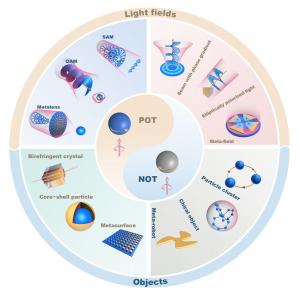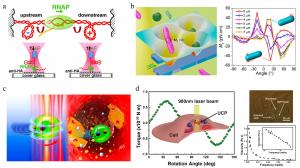A review on optical torques from engineered light fields to objects
In this review, we delve into the fundamentals and recent breakthroughs in the realm of optical micro/nano manipulation using optical torques.
CHENGDU, SICHUAN, CHINA, October 7, 2025 /EINPresswire.com/ -- Light is not only an important carrier of information but also a carrier of energy. When light interacts with matter, it can induce subtle mechanical effects, known as optical forces. This non-contact manipulation approach has led to the development of key technologies such as optical tweezers, enabling researchers to trap and manipulate cells, molecules, and micro- and nanoparticles without damaging the samples, achieving remarkable results in physics, chemistry, and life sciences.In addition to linear momentum, light also carries angular momentum. The transfer of angular momentum can induce rotation of objects at the microscopic scale, exerting what is known as optical torque. Optical torque provides rotational degrees of freedom to manipulated objects, significantly expanding the functionalities and applications of light–matter interactions. Optical Torque serves as a core technology for the manipulation of micro and nanoscale rotors and the investigation of cellular mechanics, playing a critical role in advancing biomedical research, precision measurement, and advanced manufacturing. Therefore, systematic studies of optical torque not only help to uncover deeper mechanisms of light–matter interactions but also provide new technological support for interdisciplinary applications.
Recently, the research team led by Professor Zhanshan Wang and Professor Xinbin Cheng from the School of Physical Science and Engineering at Tongji University published a review article titled “A review on optical torques: from engineered light fields to objects” in Opto-Electronic Science. The article systematically summarizes the fundamentals and recent breakthroughs in optical micro/nano manipulation based on optical torques from engineered light fields and objects, explores its applications in physics and life sciences, and provides perspectives on the future development of this field.
Light carries not only linear momentum but also spin angular momentum (SAM) and orbital angular momentum (OAM). When the angular momentum of light is transferred to matter, optical torque is generated, causing objects to rotate. As illustrated in Figure 1, optical torque can be classified into positive optical torque (POT) and negative optical torque (NOT) according to the direction of torque relative to the incident light’s angular momentum. POT primarily arises from the direct transfer of angular momentum, while NOT reflects more complex angular momentum redistribution, potentially causing objects to rotate in the opposite direction to the incident light field’s angular momentum. In recent years, researchers have utilized structured light field design, polarization control, and various micro- and nanostructured materials to achieve diversified rotational manipulation from nanoparticles to anisotropic materials and even metamaterials significantly enhancing the flexibility and precision of optical torque.
With the development of optical torque theory and experimental techniques, its applications have expanded across physics and biology. In physics, researchers have employed optical “torque wrenches” to control the rotation of micro- and nanoparticles, enabling high-sensitivity mechanical measurements, microfluidic pump actuation, and the construction of novel nanosensors. In biology, as shown in Figure 2, optical torque, with its non-contact and high-precision advantages, can directly probe the biological torque of DNA, aiding studies of gene regulation mechanisms. It can also efficiently sort cells and bacteria of different shapes and facilitate the development of biological micromotors and drug delivery systems. Additionally, optical torque can be used to measure intracellular fluid viscosity, providing unique tools for life sciences research.
In recent years, both the theory and technology of optical torque have rapidly advanced, highlighting its growing potential in micro- and nano-manipulation. Its unique advantages are particularly evident in biomedical research, precision measurement, and advanced manufacturing. Although challenges such as interaction strength and manipulation complexity remain, the integration of optical torque with various micro- and nanotechnologies, along with emerging methods such as special light fields design and AI-assisted inverse design, is expected to enable more efficient and precise manipulation strategies, opening new possibilities for future scientific research and practical applications.
This work was supported by the National Natural Science Foundation of China, National Key Research and Development Program of China, Science and Technology Commission of Shanghai Municipality, Shanghai Municipal Science and Technology Major Project, Shanghai Pilot Program for Basic Research, Fundamental Research Funds for the Central Universities, University Grants Committee/Research Grants Council of the Hong Kong Special Administrative Region, China, Germany/Hong Kong Joint Research Scheme, City University of Hong Kong.
About the Research Group:
The Institute of Precision Optical Engineering (IPOE) at Tongji University (Team leaders: Professor Zhanshan Wang, Distinguished Professor of the Changjiang Scholars Program and recipient of the National Science Fund for Distinguished Young Scholars, and Professor Xinbin Cheng, recipient of the National Science Fund for Distinguished Young Scholars.) has established the first-level discipline of Optical Science and Technology, the second-level discipline of Optics, and the undergraduate program in Optoelectronic Information Science and Engineering. At present, relying on one national platform and three provincial/ministerial platforms including the National Integrated Circuit Micro/Nano Detection Equipment Industry Metrology and Test Center (Shanghai), the MOE Key Laboratory of Advanced Micro-Structured Materials, Shanghai Frontiers Science Center of Digital Optics, and Shanghai Professional Technical Service Platform for Full-Spectrum and High-Performance Optical Thin Film Devices and Applications, the IPOE has been engaged in education, fundamental science, key technologies, and engineering application research in the field of precision optical engineering. Taking the ownership of the challenge to overcome cutting-edge scientific problems and targeting breakthroughs on core technologies, the IPOE has accomplished several significant national scientific research projects, received two State Technological Invention Award, one China Patent Award Gold Medal, and more than ten provincial/ministerial-level awards. It has now become an important base for high-level talent cultivation and advanced scientific research.
After two decades of endeavors, by maintaining “loyalty, excellence, innovation, and synergy”, the IPOE has evolved to be a significant institution with many core specialties. Meanwhile, the IPOE will grasp the opportunities presented by the country's “14th Five-Year Plan”, which reaffirms our determination to advance with the times, make the security of people our ultimate goal, dedicate ourselves to work, scale new heights, and consider our unique potentials for developing strengths beyond our core specialties.
Read the full article here: https://www.oejournal.org/oes/article/doi/10.29026/oes.2025.250014
Andrew Smith
Charlesworth
+44 7753 374162
marketing@charlesworth-group.com
Visit us on social media:
LinkedIn
YouTube
Other
Legal Disclaimer:
EIN Presswire provides this news content "as is" without warranty of any kind. We do not accept any responsibility or liability for the accuracy, content, images, videos, licenses, completeness, legality, or reliability of the information contained in this article. If you have any complaints or copyright issues related to this article, kindly contact the author above.


